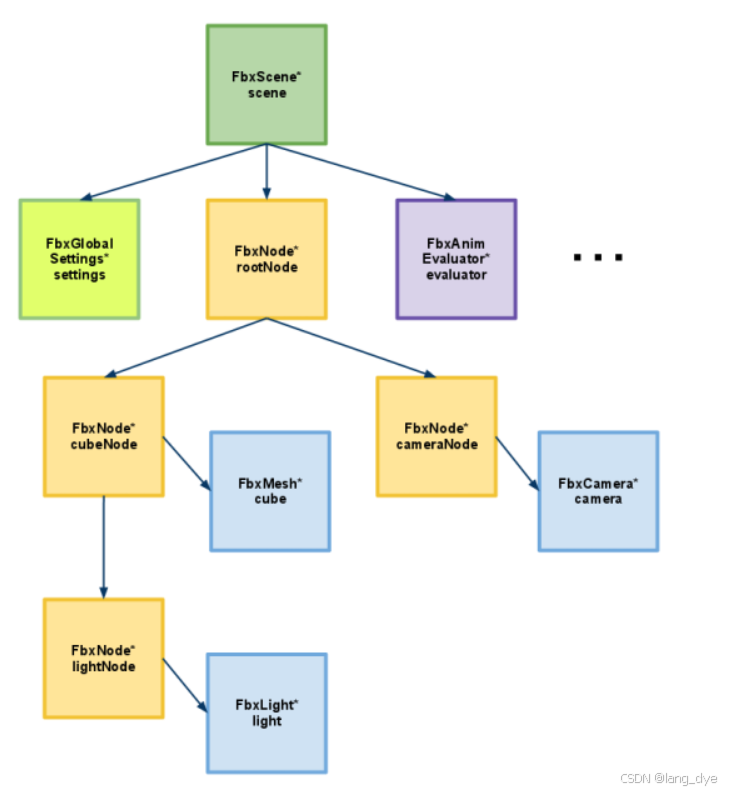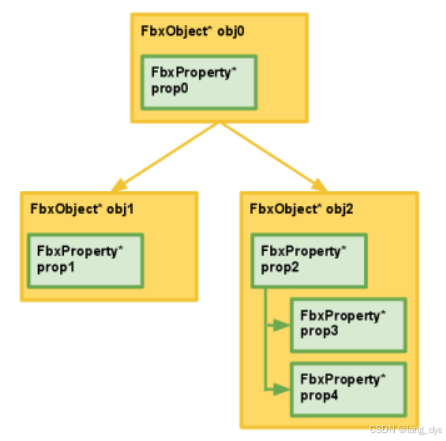Windows环境配置
FBX SDK安装后,目录下有三个文件夹:
- include 头文件
- lib 编译的二进制库,根据你项目的配置去包含相应的库
- samples 官方使用案列
动态链接
libfbxsdk.dll, libfbxsdk.lib是动态库,需要在配置属性->C/C++->预处理器->预处理器定义中添加FBXSDK_SHARED;
静态链接
libfbxsdk-md.lib, libfbxsdk-mt.lib 是两种静态库,不同的是运行库选项,在配置属性->C/C++->代码生成->运行库中设置/MD或/MT,/MDd和/MTd时debug模式。
mt编译时,将LIBCMT.lib编译到obj文件中,连接器通过它处理外部符号,会将引用的外部库集成到生成的库里面;md编译时,将MSVCRT.lib编译到obj文件中,链接器会链接到MSVCRT.dll,因此生成的库会比mt的小;
如果时debug模式的静态链接,还需要在配置属性->链接器->输入->忽略特定默认库项添加LIBCMT,配置属性->链接器->输入->附加依赖项项添加wininet.lib
注意:FBX SDK可以使用多线程,但是不保证线程安全。
FBX SDK基础知识
内存管理
FbxManager类用来管理FBX SDK对象的创建和销毁,且每一个程序里面只能有一个FbxManager的实例。
C++
// 创建FbxManager的实例
FbxManager* lSdkManager = FbxManager::Create();
// 使用FbxManager来创建对象
FbxScene* lScene = FbxScene::Create(lSdkManager, "Scene Name");
// 释放所有FbxManager分配的内存
lSdkManager->Destroy();导入导出设置
c++
FbxIOSettings ioSettings = FbxIOSettings::Create(lSdkManager, IOSROOT); // 创建FbxIOSettings
mFbxSettings->SetBoolProp(IMP_FBX_MATERIAL, true); // 设置材质导入
lSdkManager->SetIOSettings(ioSettings); // 应用设置设置导入导出对象,所有设置的默认值为true
c++
mFbxSettings->SetBoolProp(IMP_FBX_MATERIAL, true) // 输入设置,以"IMP_"为前缀
mFbxSettings->SetBoolProp(EXP_FBX_MATERIAL, true) // 输出设置,以"EXP_"为前缀导出文件格式设置
EXP_FBX 导出二进制FBX文件,能嵌入媒体文件
EXP_ASCIIFBX 导出ascii FBX文件
EXP_DXF 导出DXF文件
EXP_COLLADA 导出collada文件
EXP_OBJ 导出OBJ文件
嵌入媒体文件
只有binary fbx文件才能嵌入媒体文件。当导入有媒体文件嵌入的fbx文件(myExportFile.fbx)时,将提取嵌入的媒体文件到当前目录下的myExportFile.fbm/subdirectory文件夹中。
c++
mFbxSettings->SetBoolProp(EXP_FBX_EMBEDDED, true); // 导出Fbx binary文件时,媒体文件嵌入到导出文件中设置密码保护
导出时设置密码
c++
FbxString lString;
// 将密码设置给lString
mFbxSettings->SetStringProp(EXP_FBX_PASSWORD, lString);
mFbxSettings->SetBoolProp(EXP_FBX_PASSWORD_ENABLE, true);导入时填写密码
c++
FbxString lString;
// 将密码设置给lString
mFbxSettings->SetStringProp(IMP_FBX_PASSWORD, lString);
mFbxSettings->SetBoolProp(IMP_FBX_PASSWORD_ENABLE, true);打印支持的写入和读取文件格式
C++
void PrintWriterFormatAndReaderFormat(FbxManager* fbxManager)
{
FbxIOPluginRegistry* ioPlugin = fbxManager->GetIOPluginRegistry();
int readerFormatCnt = ioPlugin->GetReaderFormatCount();
printf("read format count = %d\n", readerFormatCnt);
for (int i = 0; i < readerFormatCnt; i++)
{
const char* extension = ioPlugin->GetReaderFormatExtension(i);
const char* desc = ioPlugin->GetReaderFormatDescription(i);
printf("extension = %s description = %s\n", extension, desc);
}
int writerFormatCnt = ioPlugin->GetWriterFormatCount();
printf("writer format count = %d\n", writerFormatCnt);
for (int i = 0; i < writerFormatCnt; i++)
{
const char* extension = ioPlugin->GetWriterFormatExtension(i);
const char* desc = ioPlugin->GetWriterFormatDescription(i);
printf("extension = %s description = %s\n", extension, desc);
}
}导入导出场景
导入场景
c++
FbxImporter* lImporter = FbxImporter::Create(lSdkManager, "");
bool lImportStatus = lImporter->Initialize(lFileName, -1, mFbxSettings); // -1 表示让fbxsdk根据文件的扩展名去判断文件的格式
if(!lImportStatus)
{
printf("Call to FbxImporter::Initialize() failed.\n");
printf("Error returned: %s\n\n", lImporter->GetStatus().GetErrorString());
exit(-1);
}
// 将文件中的内容导入到scene对象中
FbxScene* scene = FbxScene::Create(lSdkManager, "");
lImporter->Import(scene);
// 导入完成后就可以安全销毁,减少内存占用
lImporter->Destroy();索引非嵌入的多媒体文件
当ASCII FBX或其他不包含嵌入媒体的文件格式定位引用的媒体文件时,遵循下面两个步骤:
-
使用绝对路径来检查引用的多媒体文件是否存在,这个绝对路径是导出场景到Fbx文件时指定的
FbxFileTexture::SetFileName()C++// The resource file is in the application's directory. FbxString lTexPath = gAppPath + "\\Crate.jpg"; // Create a texture object. FbxFileTexture* lTexture = FbxFileTexture::Create(pScene,"Crate Texture"); // Set the texture's absolute file path. lTexture->SetFileName(lTexPath.Buffer()) -
如果绝对路径不存在多媒体文件,则使用相对路径,相对路径在导出场景到FBX文件时会自动保存
获取导入文件的版本
c++
int lFileMajor, lFileMinor, lFileRevision;
lImporter->GetFileVersion(lFileMajor, lFileMinor, lFileRevision);导出场景
c++
FbxExporter* lExporter = FbxExporter::Create(lSdkmanager, "");
const char* lFilename = "file.fbx";
bool lExportStatus = lExporter->Initialize(lFilename, -1, lSdkManager->GetIOSettings());
if(!lExportStatus) {
printf("Call to FbxExporter::Initialize() failed.\n");
printf("Error returned: %s\n\n", lExporter->GetStatus().GetErrorString());
return false;
}
FbxScene* scene = FbxScene::Create(lSdkManager, "myScene");
lExporter->Export(lScene);
lExporter->Destroy();坐标系和单位转换
我们读取FBX文件的数据到自己的应用中,需要的坐标系和单位可能和FBX文件的不一样,这时需要去修改这些设置。使用FBX SDK创建的对象是右手坐标系,Y轴向上。
c++
// 转换为OpenGL坐标系
FbxGlobalSettings& globalSettings = mScene->GetGlobalSettings();
if (globalSettings.GetAxisSystem() != FbxAxisSystem::OpenGL)
{
FbxAxisSystem::OpenGL.ConvertScene(mScene);
}
// 转换为m作为单位
FbxSystemUnit systemUnit = globalSettings.GetSystemUnit();
if (globalSettings.GetSystemUnit() != FbxSystemUnit::m)
{
const FbxSystemUnit::ConversionOptions options = {
false, // mConvertRrsNodes
true, // mConvertLimits
true, // mConvertClusters
true, // mConvertLightIntensity
true, // mConvertPhotometricLProperties
true, // mConvertCameraClipPlanes
};
FbxSystemUnit::m.ConvertScene(mScene, options);
}注意:坐标系转换只会作用到节点Transform的pre-rotaion和动画,单位转换只会作用到节点Transform的scale和动画,并不会作用到顶点的值,比如位置,法线和UV。因此顶点值的转换需要自己去处理。
OpenGL和DirectX坐标系的转换
OpenGL坐标系是Y轴向上,X轴向右,Z轴向屏幕外,DirectX坐标系是Y轴向上,X轴向右,Z轴向屏幕内。如果将DirectX坐标系的顶点转换为OpenGL坐标系的顶点,我们以OpenGL的坐标系为世界坐标系,三个轴的基向量为 x ⃗ 0 ( 1 , 0 , 0 ) , y ⃗ 0 ( 0 , 1 , 0 ) , z ⃗ 0 ( 0 , 0 , 1 ) \vec x_0(1,0,0),\vec y_0(0,1,0),\vec z_0(0,0,1) x 0(1,0,0),y 0(0,1,0),z 0(0,0,1),则DirectX坐标系的三个轴的基向量为 x ⃗ d ( 1 , 0 , 0 ) , y ⃗ d ( 0 , 1 , 0 ) , z ⃗ d ( 0 , 0 , − 1 ) \vec x_d(1,0,0),\vec y_d(0,1,0),\vec z_d(0,0,-1) x d(1,0,0),y d(0,1,0),z d(0,0,−1)。若点 P ( x p , y p , z p ) P(x_p,y_p,z_p) P(xp,yp,zp)为DirectX坐标系中的一点,将其转换为OpenGL坐标系为 ( ( x p , 0 , 0 ) ⋅ x ⃗ d , ( 0 , y p , 0 ) ⋅ y ⃗ d , ( 0 , 0 , z p ) ⋅ z ⃗ d ) = ( x p , y p , − z p ) ((x_p,0,0) \cdot \vec x_d, (0,y_p,0) \cdot \vec y_d, (0,0,z_p) \cdot \vec z_d)=(x_p,y_p,-z_p) ((xp,0,0)⋅x d,(0,yp,0)⋅y d,(0,0,zp)⋅z d)=(xp,yp,−zp),所以x,y坐标保持不变,z坐标取反。顶点的位置,法线可以按照这个规则处理。
因为OpenGL是右手坐标系,DirectX是左手坐标系,它们三角面的顶点的顺序是相反,所以 ( v 1 , v 2 , v 3 ) (v_1,v_2,v_3) (v1,v2,v3)要变成 ( v 1 , v 3 , v 2 ) (v_1,v_3,v_2) (v1,v3,v2)。
顶点的UV, V n e w = 1 − V V_{new}=1-V Vnew=1−V,怎么得出来的,目前不清楚。
FBX场景

每个FBX文件是一个FbxScene,FbxScene由FbxNode以树状层级结构组成。
一个场景由许多元素组成,包含:meshes, lights, cameras, skeletons, NURBS等,这些元素继承FbxNodeAttribute,FbxNode是一个或多个场景元素的容器。
C++
FbxNode* lRootNode = lScene->GetRootNode();
if(lRootNode) {
for(int i = 0; i < lRootNode->GetChildCount(); i++)
PrintNode(lRootNode->GetChild(i));
}
C++
// Print a node, its attributes, and all its children recursively.
void PrintNode(FbxNode* pNode) {
const char* nodeName = pNode->GetName();
FbxDouble3 translation = pNode->LclTranslation.Get();
FbxDouble3 rotation = pNode->LclRotation.Get();
FbxDouble3 scaling = pNode->LclScaling.Get();
// Print the node's attributes.
for(int i = 0; i < pNode->GetNodeAttributeCount(); i++)
PrintAttribute(pNode->GetNodeAttributeByIndex(i));
// Recursively print the children.
for(int j = 0; j < pNode->GetChildCount(); j++)
PrintNode(pNode->GetChild(j));
}FBX对象,属性,特性
FbxObject
FBX对象都继承于FbxObject,比如FbxScene,FbxNode,FbxImporter, FbxExporter, FbxCollection等。
FbxCollection是FBX object的容器,FbxAnimLayer, FbxAnimStack, FbxScene都是继承于它。
遍历场景的动画
c++
int numStacks = mScene->GetSrcObjectCount<FbxAnimStack>();
for (int i = 0; i < numStacks; i++)
{
FbxAnimStack* animStack = FbxCast<FbxAnimStack>(mScene->GetSrcObject(i));
int numAnimLayers = animStack->GetMemberCount<FbxAnimLayer>();
for (int layerIdx = 0; layerIdx < numAnimLayers; layerIdx++)
{
FbxAnimLayer* animLayer = animStack->GetMember<FbxAnimLayer>(layerIdx);
···
}
}FbxProperty
FbxProperty目前我知道的就是获取FbxNode的变换数据。
C++
FbxDouble* lTranslation = lNode->LclTranslation.Get().mData;
FbxDouble* lRotation = lNode->LclRotation.Get().mData;
FbxDouble* lScaling = lNode->LclScaling.Get().mData;属性的创建和销毁
C++
// 创建FBX Property
FbxProperty p = FbxProperty::Create(pScene, DTDouble3, "Vector3Property");
FbxSet<FbxDouble3>(p, FbxDouble3(1.1, 2.2, 3.3);
// ... initialize FbxNode* lNode ...
FbxDouble3 translation = lNode->LclTranslation.Get();
FbxDouble3 rotation = lNode->LclRotation.Get();
FbxDouble3 scaling = lNode->LclScaling.Get(); FbxNodeAttribute
FbxNodeAttribute定义了一个场景元素,比如FbxMesh,FbxSkeleton。
遍历FbxNode的FbxNodeAttribute
C++
FbxNode* pNode;
int attrCount = pNode->GetNodeAttributeCount();
for (int i = 0; i < attrCount; i++)
{
FbxNodeAttribute* attribute = pNode->GetNodeAttributeByIndex(i);
FbxNodeAttribute::EType type = attribute->GetAttributeType();
switch (type)
{
case fbxsdk::FbxNodeAttribute::eSkeleton:
mSkeletonNodes.push_back(pNode);
break;
case fbxsdk::FbxNodeAttribute::eMesh:
mFbxMeshes.push_back((FbxMesh*)attribute);
break;
default:
break;
}
}对象和属性的关系
FbxObjec和FbxObject,FbxProperty和FbxProperty,FbxObject和FbxProperty直接可以建立父子关系,FBX SDK里面叫Connection。

GetSrcXXX可以理解为获取子对象,GetDstXX可以理解为获取父对象
- object-property
FbxObject::GetSrcProperty()获取节点的属性,FbxProperty::GetDstObject()获取属性绑定的节点 - object-object
FbxObject::GetSrcObject()获取子节点,FbxProperty::GetDstObject()获取父节点 - property-property
FbxProperty::GetSrcProperty()获取子属性,FbxProperty::GetDstObject()获取父属性
参考:
- FBX SDK文档
- 官方案列